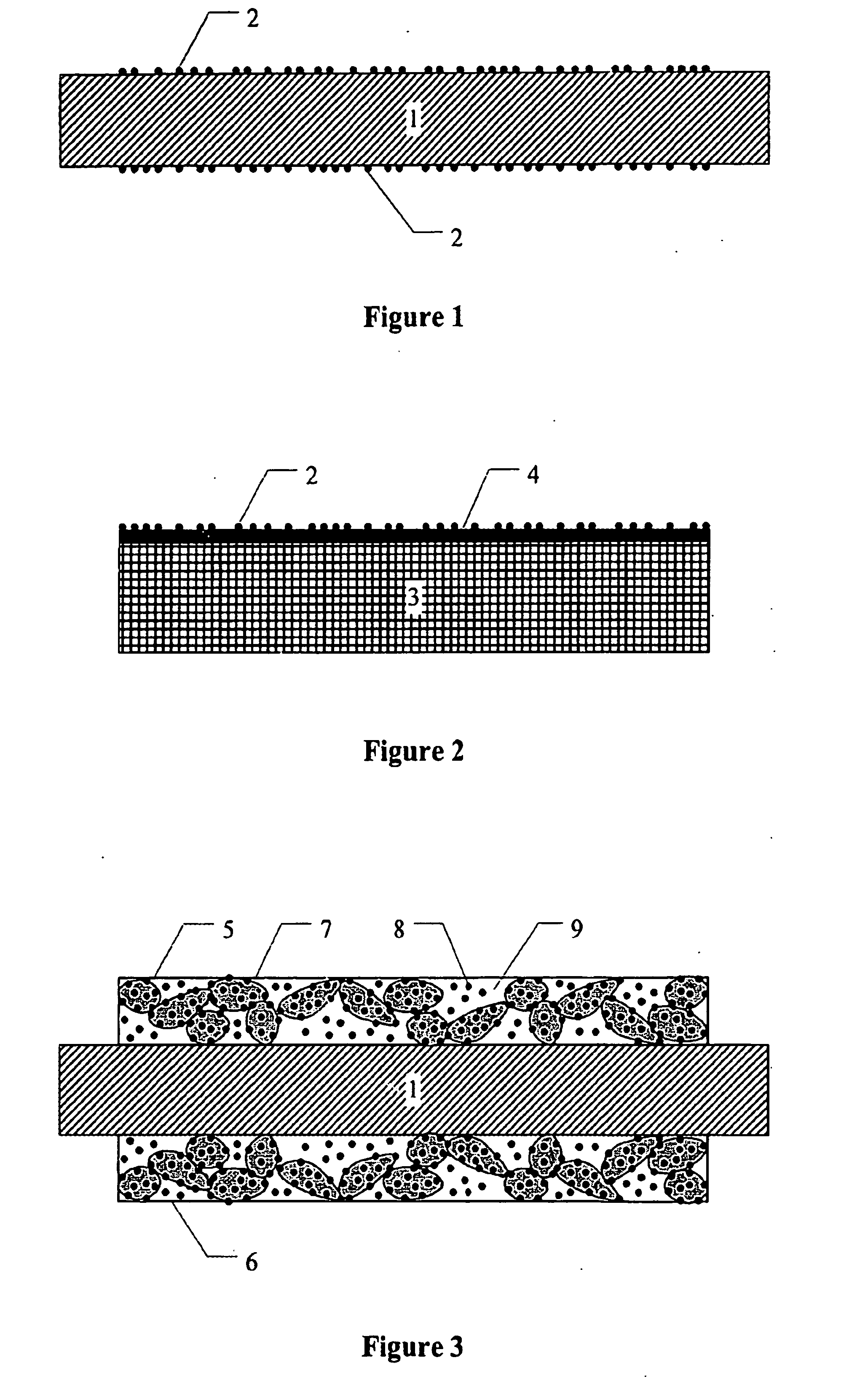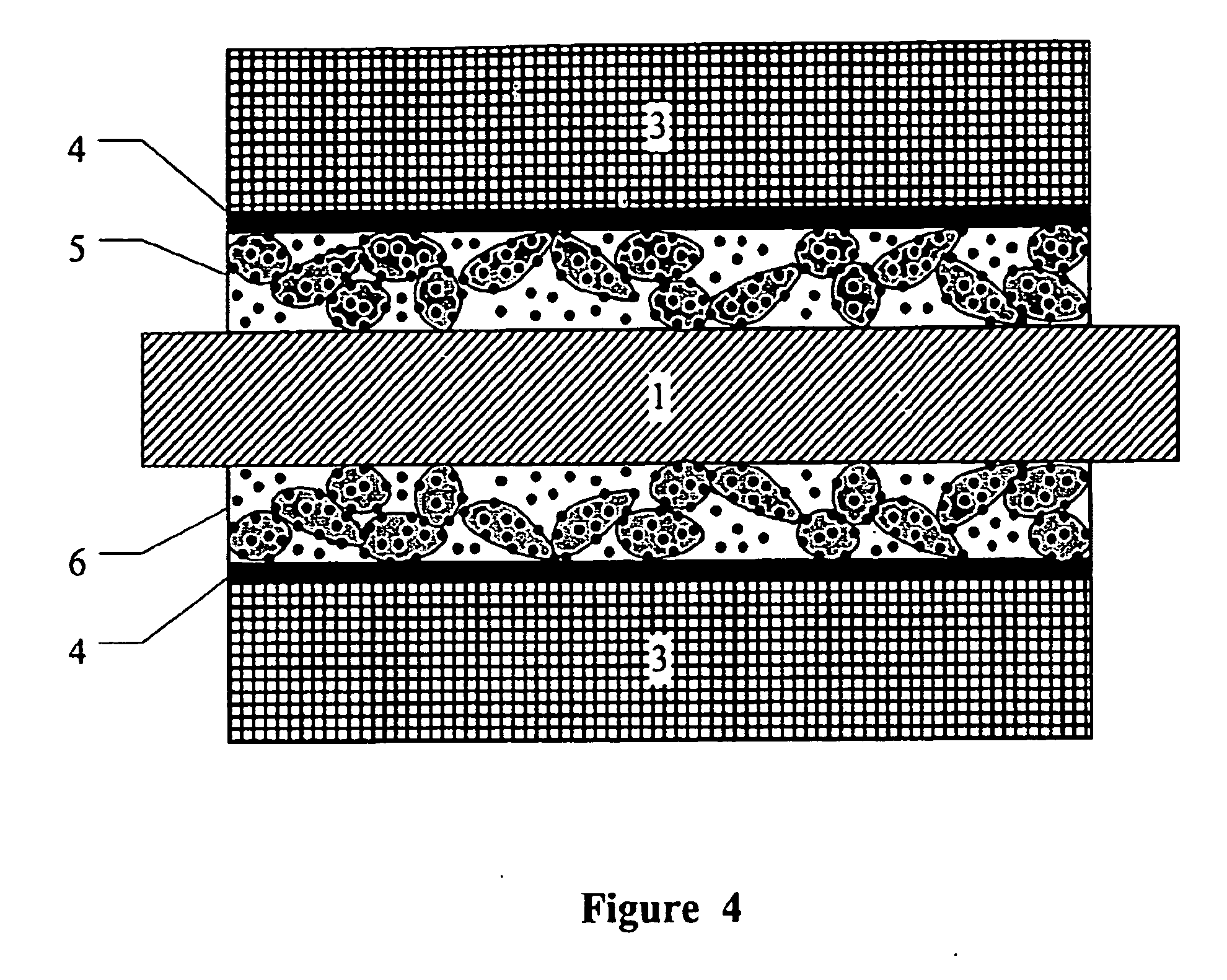Noble metal nanoparticles, a process for preparing these and their use
a technology of nanoparticles and nanoparticles, which is applied in the manufacture of final products, metal/metal-oxide/metal-hydroxide catalysts, non-conductive materials with dispersed conductive materials, etc., can solve the problems of only providing electrocatalysts, contaminating the catalytically active catalyst surface, and complex process. cost, easy removal
- Summary
- Abstract
- Description
- Claims
- Application Information
AI Technical Summary
Benefits of technology
Problems solved by technology
Method used
Image
Examples
example 1
a) Preparing Pt Nanoparticles
[0055] 11.1 g of a solution of bis(ethanolammonium) hexahydroxoplatinate (Pt content 9 wt. %; total chlorine content 2, Hanau) were added dropwise to 1.5 l of fully deionized water in which 1.0 g of gum arabic (Merck) had previously been dissolved. Then, 1 l of ethanol was added with stirring and the resulting mixture was heated, wherein the mixture turned black. The solution was kept under reflux for one hour at 85° C. and then concentrated to a volume of 100 ml by evaporation. The colloidal solution prepared in this way had a pH value of 5.9 and contained 10 g Pt / l (1 wt. % Pt) and 10 g / l (1 wt. %) of the stabilizer gum arabic. The ratio of Pt nanoparticles to stabilizer was thus 1:1. The total chlorine content of the solution was less than 10 ppm. The average size of the Pt particles was determined using TEM (transmission electron microscopy) and was 2 nm.
b) Catalyzing Ionomer Membranes
[0056] 5.6 g of the colloidal solution (Pt content 1 wt. %) w...
example 2
a) Preparation of Pt / Ru Nanoparticles
[0059] 7.28 g of a solution of bis(ethanolammonium) hexahydroxoplatinate (Pt content 9 wt. %; total chlorine content 2, Hanau) and 2.265 g of a solution of ruthenium nitrosylnitrate (Ru content 15 wt. %, total chlorine content 2, Hanau) were added dropwise to 1.5 l of fully deionized water, in which 1.0 g of gum arabic (Merck) had been dissolved. Then 1 l of ethanol was added with stirring and the resulting mixture was heated, wherein it turned black. The solution was held under reflux for one hour at 85° C. and then concentrated by evaporation to a volume of 100 ml. The colloidal solution obtained in this way had a pH value of 5.7 and contained 10 g PtRu / l (1 wt. % PtRu, atomic ratio 1:1) and 10 g / l (1 wt. %) of the stabiliser gum arabic. The ratio of PtRu nanoparticles to stabilizer was thus 1:1. The total chlorine content of the solution was less than 50 ppm. The average size of the PtRu particles was determined by TEM and was 2.5 nm.
B) Ca...
example 3
[0061] 2.22 g of a solution of bis(ethanolammonium) hexahydroxoplatinate (Pt content 9 wt. %; total chlorine content 2, Hanau) were added dropwise to 1.5 l of fully deionized water in which 0.2 g of Kelzan (xanthan gum, Lubrizol-Langer, Bremen) had previously been dissolved. Then 1 l of isopropanol was added with stirring and the resulting mixture was heated, wherein it turned black. The solution was held under reflux for one hour at 85° C. and then concentrated by evaporation to a volume of 100 ml. The colloidal solution obtained in this way had a pH value of 5.6 and contained 2 g Pt / l (0.2 wt. % Pt) and 2 μl (0.2 wt. %) of the stabilizer Kelzan. The ratio of Pt nanoparticles to stabilizer was thus 1:1. The total chlorine content of the solution was less than 30 ppm. The average size of the Pt particles was determined by TEM and was 2.5 nm.
[0062] An ionomer membrane was catalyzed in the same way as described in example 1 and a membrane with a total platinum loading of 0.2 mg Pt / cm...
PUM
| Property | Measurement | Unit |
|---|---|---|
| temperatures | aaaaa | aaaaa |
| temperatures | aaaaa | aaaaa |
| size | aaaaa | aaaaa |
Abstract
Description
Claims
Application Information
 Login to View More
Login to View More - R&D
- Intellectual Property
- Life Sciences
- Materials
- Tech Scout
- Unparalleled Data Quality
- Higher Quality Content
- 60% Fewer Hallucinations
Browse by: Latest US Patents, China's latest patents, Technical Efficacy Thesaurus, Application Domain, Technology Topic, Popular Technical Reports.
© 2025 PatSnap. All rights reserved.Legal|Privacy policy|Modern Slavery Act Transparency Statement|Sitemap|About US| Contact US: help@patsnap.com



